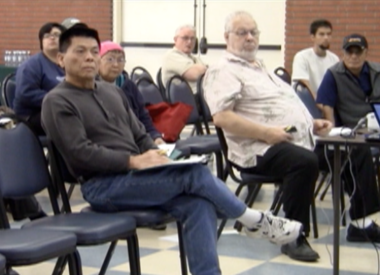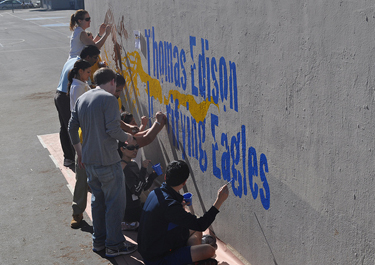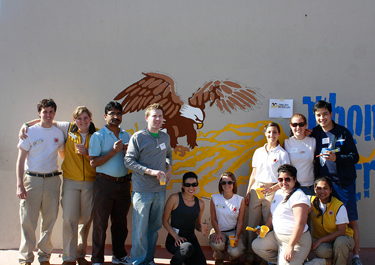 Making homes energy efficient and creating more water self-sufficiency is a top priority for the City of Hawthorne and the South Bay Environmental Services Center.
Making homes energy efficient and creating more water self-sufficiency is a top priority for the City of Hawthorne and the South Bay Environmental Services Center.
The South Bay Environmental Services Center hosted a seminar for Hawthorne homeowners concerning the Energy Upgrade California and Water Reliability 2020 programs.
By 2020, the Water Reliability 2020 program aims to increase the use of local water resources to 66 percent of the South Bay’s total water usage. Currently, only 33 percent is from a locally-produced water supply.
Performance incentive checks range from $1,250 to $4,000 at the state-level as part of the Energy Upgrade California program. An additional rebate worth $500 is also being offered through Los Angeles County for homes achieving 20 percent energy-savings or better.
One resident of Hawthorne decided to take advantage of the incentives being given last year for energy efficient upgrades and installed 20 new windows in his home, at a cost of $16,000.
“Part of the reason was the wood was peeling off and the other reason was energy efficiency,” Wayne Beach said. “I see a significant change in my monthly bill, between 15 to 20 percent.”
Beach says that he was planning on replacing his windows for a while and the energy rebate motivated him to take action. He has been told that he will receive a rebate of about $1,500 in this year’s tax returns and says that any amount is helpful.
The South Bay Environmental Services Center encourages residents to look into the rebates and incentives being given for energy and water efficiency.
Grace Farwell, an environmental analyst, with the South Bay Environmental Services Center, is confident that the Water Reliability 2020 program will be a success.
“It’s through water conservation and through water recycling,” Farwell said.
 Residents were given suggestions on how they can contribute to the Water Reliability program’s success. The incentive is that they will also see a decrease in their monthly utility bills. Simple things as turning off the water when brushing teeth, taking time-limited showers and running a full load of dishes or laundry help decrease energy and water consumption. Farwell said she mindfully applies these energy and water-saving habits in her own home.
Residents were given suggestions on how they can contribute to the Water Reliability program’s success. The incentive is that they will also see a decrease in their monthly utility bills. Simple things as turning off the water when brushing teeth, taking time-limited showers and running a full load of dishes or laundry help decrease energy and water consumption. Farwell said she mindfully applies these energy and water-saving habits in her own home.
“A lot of times we have to wait for the shower to get hot, so I put a bucket in the shower to collect the cold water and use it later to water my plants,” Farwell said.
Alternative energy sources, such as solar power, are available, but usable water is a natural resource that has long been scarce in Southern California and is getting a lot worse.
“Water shortage is a reality especially for Southern California. Because of the fact that we don’t produce or contribute to the source. We are users and takers of other people’s water collections,” Farwell said.
Even with the recent rainfall, the water went into the ground and out into the ocean because Southern California’s water system isn’t designed to capture the runoff. The South Bay relies heavily on the snowmelt and snowpack in Northern California and from the Colorado River, but in recent years, environmentalists in Northern California have limited the amount of water that they distribute.
“As the population continues to increase, and the water supply remains restricted, we are going to see higher and higher costs for water. There may be water rationing and more restrictions put on us for the actual use of water,” Farwell said.
Many of the cities in the South Bay have water ordinances that restrict the number of days residents can water their lawns. But cities do not have the staff power to enforce them.
“They are really relying on the good heartedness of their residents to follow through,” Farwell said.
One of the main issues may simply be awareness. Many residents say that they are not aware of the water ordinances in place in their city.
Kiran Magiawala, a retired engineer and longtime Hawthorne resident, lives in an apartment complex and does not have direct control over his complex’s external water use. But he has contacted the building manager many times to ask to make the apartments more energy and water efficient. In the meantime, Magiawala said he does what he can.
“I would have more enjoyment out of taking a 20-minute hot shower,” he said. “But I ask myself at what cost I would be doing it. It is a philosophical matter of mindful consumption.”









 An estimated 1,000 volunteers gathered at Thomas A. Edison Middle School to celebrate Martin Luther King Jr. Day by participating in City Year Los Angeles’ day of service.
An estimated 1,000 volunteers gathered at Thomas A. Edison Middle School to celebrate Martin Luther King Jr. Day by participating in City Year Los Angeles’ day of service.  The bigger message is that of “community.” Building, creating, and connecting a community, a message that Dr. Martin Luther King Jr. also preached.
The bigger message is that of “community.” Building, creating, and connecting a community, a message that Dr. Martin Luther King Jr. also preached.




